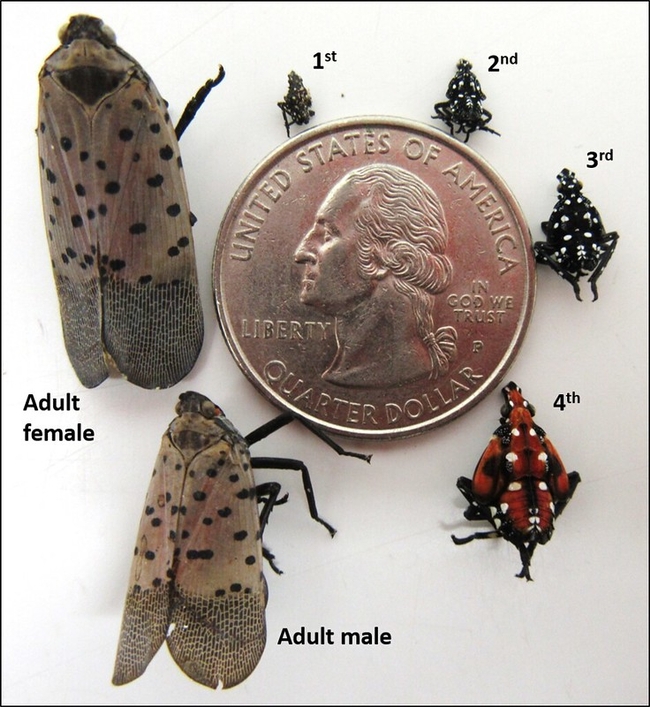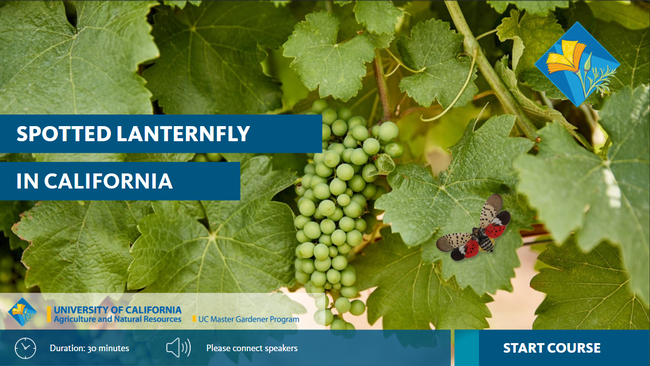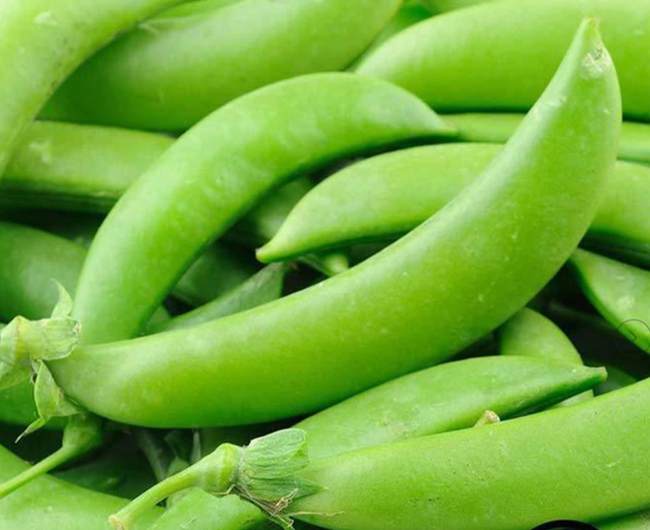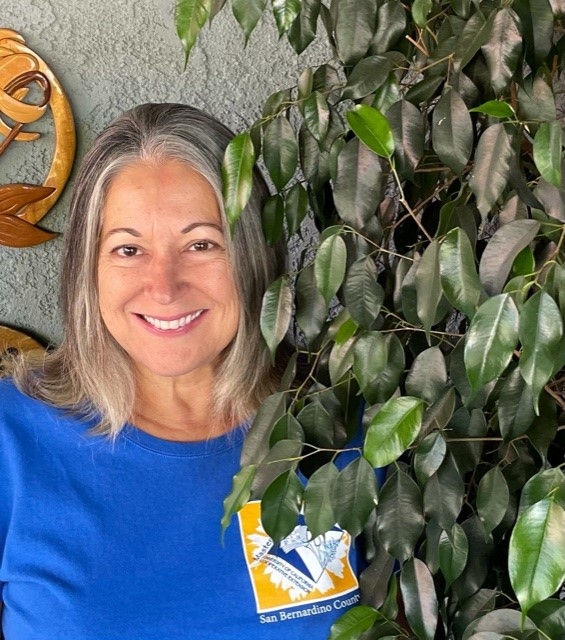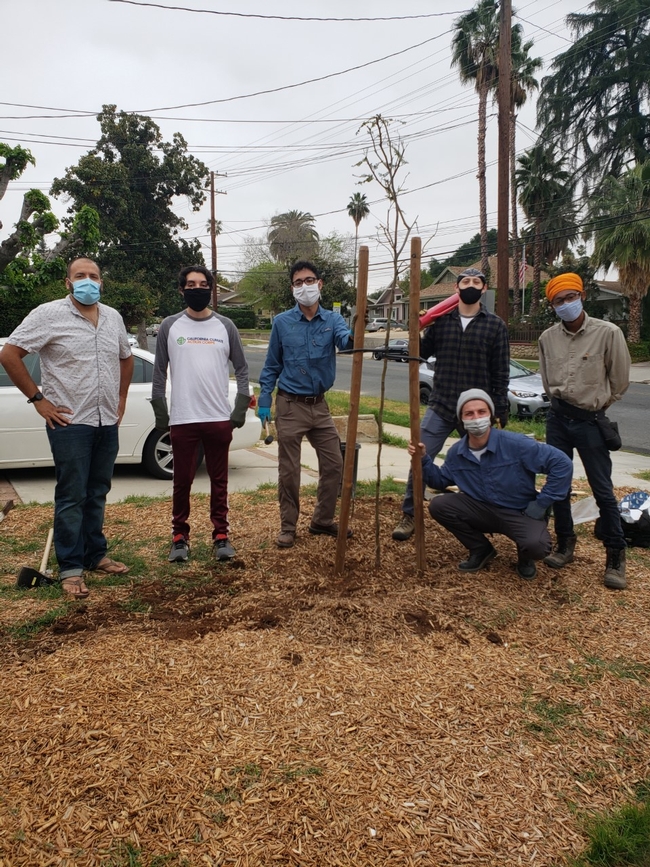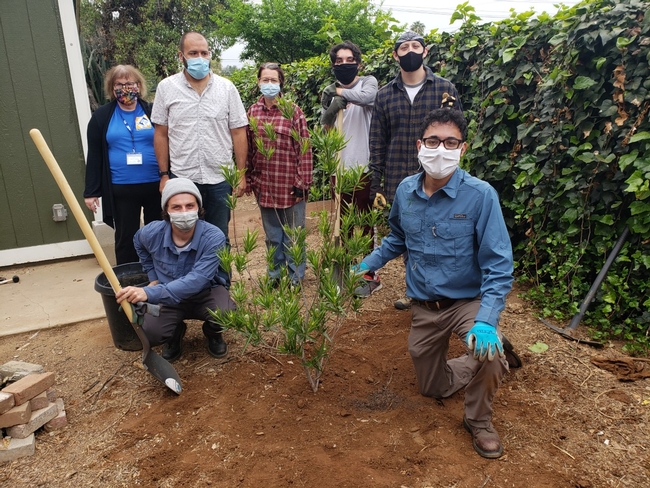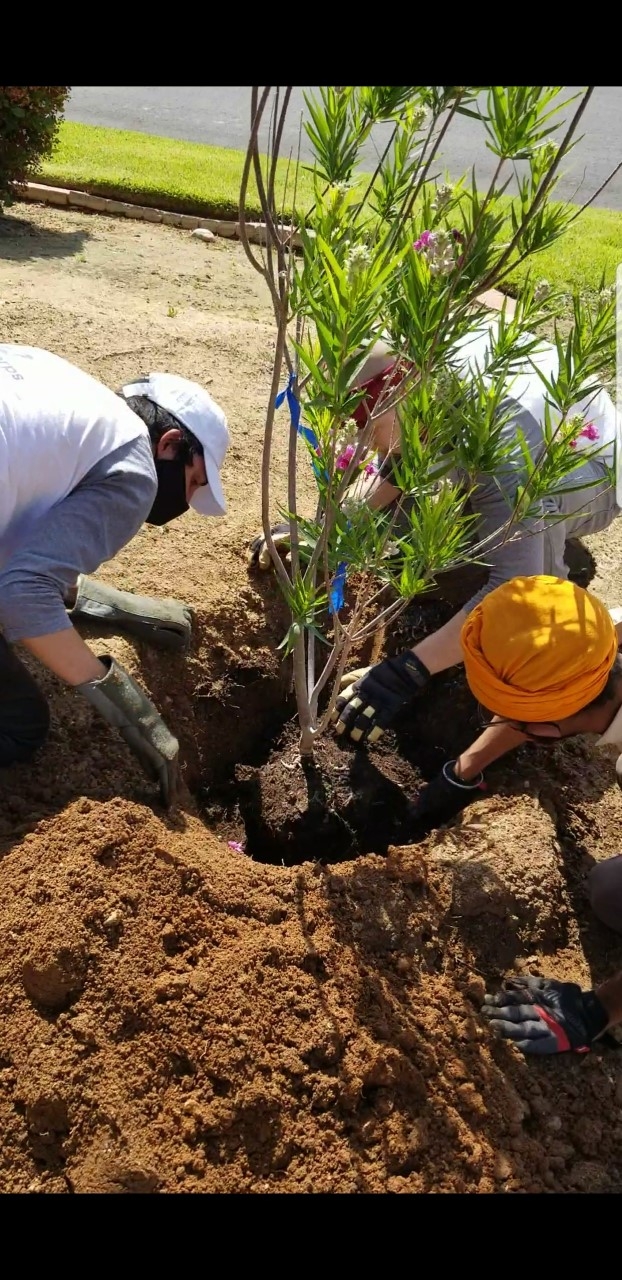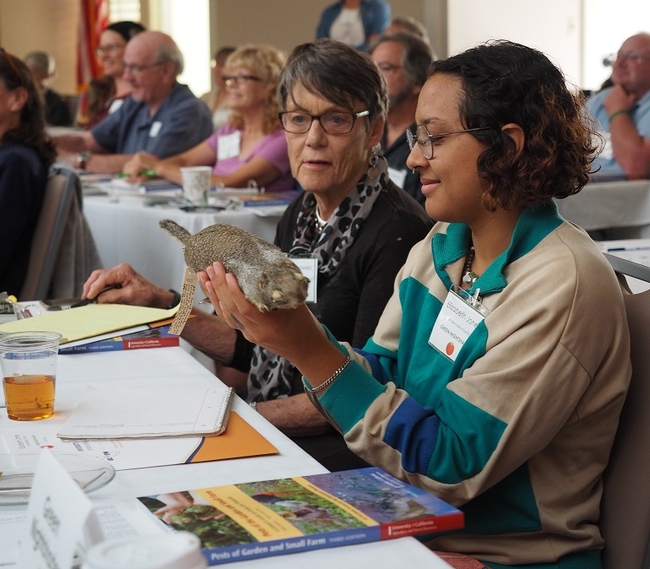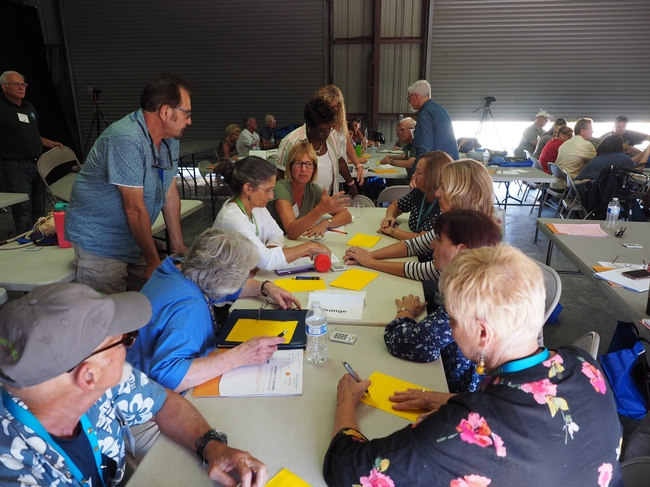Posts Tagged: Pest management
UC Master Gardener Program Launches eLearning course about the Invasive Spotted Lanternfly
We are excited to announce the release of our “Spotted Lanternfly in California” eLearning course, hosted on eXtension Campus. This course is designed to inform the public, UC Master Gardeners and other stakeholders of the threat posed by spotted lanternfly (SFL) to the state of California. The interactive online training includes an overview of spotted lanternfly ecology and empowers learners to detect and report spotted lanternfly sightings in California.
Spotted Lanternfly
SLF is a destructive invasive insect threatening agricultural and ornamental plants across the United States. Although the pest is not in California at this time, a key to slowing its spread is early detection and rapid response if detected. Through the education of California residents and resource professionals, we can all be part of keeping this invasive pest at bay.
With the assistance of the California Department of Food and Agriculture, UC Academics, and Penn State Extension, the UC Master Gardener Program “Spotted Lanternfly in California” eLearning course was created and is now available to all. Pest information and additional resources are available online.
How to Enroll
Course enrollment is free and accessed through eXtension Campus, you must either have or create a free login to enroll in the course. If you encounter problems or have questions about creating your account, please see the Campus Help Page. The course takes approximately 40 minutes and includes a graded quiz, completion time may vary by user. Learners may stop and restart, or take as many times as needed.
How to Receive a Certificate
To receive a certificate for the “Spotted Lanternfly in California” eLearning course, you must view and complete the module, as well as pass the quiz with a score of 80% or higher. Once you have passed the quiz, you can print a certificate and collect a virtual Spotted Lanternfly eLearning badge.
Continuing Education
UC Master Gardeners are eligible for one hour of continuing education for completing the “Spotted Lanternfly in California” eLearning course. It is the volunteers' responsibility to enter their hours in the Volunteer Management System to receive credit.
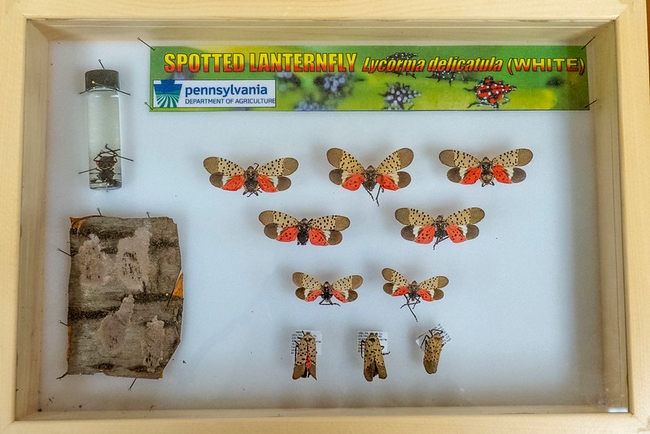
SLF Display
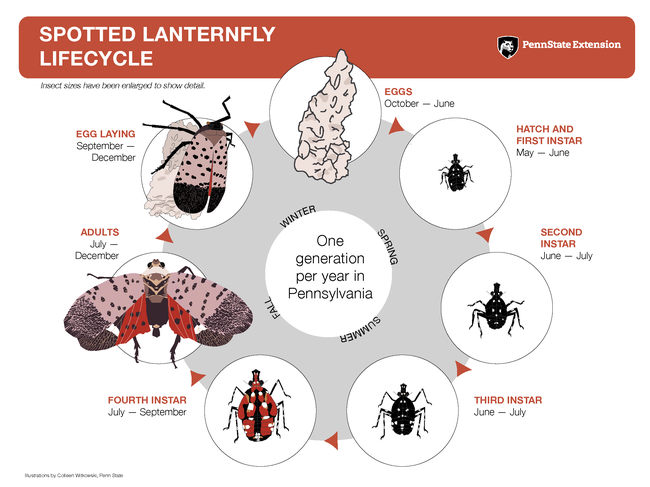
SLF Lifecycle
How do plants "communicate"?
o you ever wonder if plants “communicate” with each other? If so, you're not alone. The research on this important and fascinating topic has increased dramatically in the last decade. My interest in it dates back decades to my graduate school thesis that involved how phenolic acids exuded by the roots of garden pea (Pisum sativum) accessions from around the world warded off weeds that would otherwise have crowded them out. This was an early form of biological weed control for sure! The seeds we studied were 20-30 years old and had been carefully stored and preserved in USDA facilities for research such as this.
They were all non-hybrids that had unadulterated natural genetic qualities. While I am in no way suggesting that plant breeding isn't overall a positive advancement, there are instances where something is lost when something is gained, and genes are certainly no exception! Sometimes breeding for an improvement in one facet (production per acre, nutrition, etc.) results in the loss of another genetically controlled factors that may be negative or positive.
At about the same time I was pursuing my research described above at University of Minnesota, University of Washington zoologist David Rhoades demonstrated how some plants defend themselves against insect attacks by changing the nutritional and/or taste of their foliage. In turn, insects that otherwise would chow down on the tasty leaves look elsewhere for their lunch. Since then, research identifying the multiple paths that plants use to exchange information with neighboring plants (largely within their own species) and ward off herbivores (organisms feeding mostly on plants), diseases, and weeds has nearly tripled. While a lot of this chemical information exchange relates to the release of volatile organic compounds in the root zone and through the air, electrical signaling among plants also occurs.
Below are a few recent examples:
-Lima beans attacked by insects signaled nearby lima bean plants who built up defenses to avoid damage
-Lodgepole pines attacked by a beetle signaled neighboring trees who had time to prepare for attack.
While, traditionally, research identified these chemical warnings occurring only in neighboring plants of the same species, Cornell researchers discovered that sagebrush (Artemisia tridentata)with insect damage can release chemical signals recognized by wild tobacco (Nicotiana attenuata). In turn, the tobacco plants pump up their arsenal of chemical defenses to avoid damage. (Interestingly, the tobacco plants don't waste precious nitrogen and carbon on defense mechanisms until they are actually attacked since these elements need to be conserved as much as possible for future seed production.)
Ted Farmer's team at University of Lausanne, attached leaves of thale cress (Arabidopsis thaliana) with microelectrodes prior to infesting them with Egyptian cotton leafworms. Almost immediately, voltage changes radiated outward from the damaged leaf tissue in the damaged plant and other neighboring plants resulting in accumulation of jasmonic acid which reduced further damage. Genes responsible for transmitting the electrical signal create membrane channels inside cell walls that provide a conduit for charged ions. The genes in some ways parallel receptors that animals rely on to relay sensory signals through their bodies.
And last but certainly not least, Kudos to UC Davis ecologist/entomologist Richard “Rick” Karban, who was named a fellow of the Ecological Society of America (ESA) for “his innovative contributions to community and evolutionary ecology, especially through providing conceptual advances and rigorous experimental work on plant-insect interactions." Want to learn a log more about this topic." Still "hungry" for more information on this topic? You're in luck! Dr. Karban wrote a 240-page book entitled: Plant Sensing and Communication (University of Chicago Press).
Master Gardener Spotlight: Redlands Tree Canopy Enhancement Team
It's only right that our University of California Cooperative Extension (UCCE) San Bernardino County Master Gardener ‘Trees for Tomorrow' team of volunteers are our featured ‘Spotlight' Master Gardener volunteers for September, 2021. They provided vital education to Redlands residents receiving gratis trees through a multi-partnership grant obtained by Inland Empire Resource Conservation District Manager Mandy Parkes.
It's an honor and privilege to recognize UCCE San Bernardino County Master Gardener Project Leader Debbie LeDoux and her dedicated team of 'Trees for Tomorrow' volunteers: Zhibo (Sandy) Anderson; Consuelo (Connie) Davis (pictured); Pam O'Connell; Gail Sefl; and Husam Yousef. These dedicated Master Gardeners were tasked with helping residents select, plant and care for drought, heat, and pest tolerant trees. (Species including Chilopsis linearis 'Bubba', and Pistacia x 'Red Push' were selected due to their excellent performance in our University of California/United States Forest Service research project as 'climate-ready' trees able to withstand harsh conditions related to our changing climate.) Working with a team of California Climate Action Corps volunteers, civic leaders, Common Vision Coalition, and other groups, nearly 100 trees were planted in yards and parks lacking the preferred 25% tree canopy cover.
Trees can cool urban heat islands by 50 degrees Fahrenheit or more during spring and summer, creating welcome oases in hot inland communities. With spring 2021 temperatures so high they broke previous records on multiple dates, the project is especially timely and necessary.
In addition to proper tree selection, trees require the right long-term care. Master Gardeners will continue to provide advice on irrigation, pruning, fertilizing and pest control to residents receiving trees long after the trees are planted. This is critical since an average urban tree lives less than 20% of its potential lifespan due largely to poor care. The long-term engagement of Master Gardeners with residents is as important as is selecting the right species.
UCCE Master Gardeners are all volunteers, giving of their time and talents to enhance the quality of life for individuals and families who call San Bernardino County their home. Each Master Gardener is required to complete a rigorous 18-week training class complete with exams, class projects, and lots of participation! Due to COVID-19, volunteers had to master key horticultural concepts during the first ever all on-line training class. Only recently have they been able to meet fellow Master Gardener graduates and, in some cases, the Redlands residents they mentored through the tree canopy enhancement project. They truly exemplify community spirit and all it takes to successfully work together under adverse conditions. Kudos to each and every one of you from Master Gardener Coordinator Maggie O'Neil and myself! You are creating a cooler, greener and healthier environment for our children's children.
I asked the honored Master Gardeners their thoughts on the project. Here's what they had to say:
“The Redlands tree canopy project was the best volunteer project ever. In the midst of Covid-19, horrific politics and way too many good byes, it was a truly joyous experience. The legacy of being a part of the group that promoted healthy sustainable trees, knowledge of how to plant and care for them, tips on maintaining their health and beauty was the absolute best. For me as a Master Gardener, it was so much fun. I loved the site walks and getting to help our participants select the perfect sustainable trees for their properties. What started as a one-on-one visit often expanded to an enlarged group of neighbors and extended family. I got to give out many handouts and publications and promote our excellent Master Gardener program. I got to share our helpline email and phone numbers. I love the fact that I have been asked to revisit sites to see how great they are doing (once to make sure the tree did not look funny!). I receive emails every now and then asking me questions and showing me pictures of "Our Trees.” So much fun, Janet. Thank you. By far the coolest project ever! Pam O'Connell
------------------------------------------------------------------------------------------------------------------
There are a few things that really made an impact on me.1) It was rewarding to attend the Zoom presentation you developed that provided education to various professionals on the importance of planting sustainable trees. I found it to be open and inclusive allowing for good interchange of ideas and concerns.2) There are many beautiful trees that are sustainable.3) Reaching out to the community to offer beautiful, sustainable trees was a worthwhile way to show how various organizations can work together to benefit the community while trying to improve our environment.4) When dealing with homeowners that belong to an HOA, additional time and communication may be needed to assist them in obtaining approval for trees from their HOA's. Connie Davis
-----------------------------------------------------------------------------------------------------------------
"I see tree planting efforts similar to what a trend of the future is to combat climate change and increase awareness of the importance of trees and tree canopies in our neighborhoods. Not only that but I see this project expanded to other cities in the county of San Bernardino. The continuity of this project is so valuable so that we can see the positive impact on the environment and the well-being of San Bernardino residents in the coming decades. I see this important work being organized and well-coordinated by involving the appropriate stakeholders at all stages of the planning project. It is about time to give back what we have taken for tens of years!" Husam Yousef
------------------------------------------------
It was rewarding to see local homeowners excited about planting trees and grateful for the program providing them. Gail Sefl
---------------------------------------------
THANK YOU ALL! Janet Hartin and Maggie O'Neill
Vegetable Pest Management Training Series a Success
It may seem odd to see seventy-five people at a hotel conference center learning about insects and rats on vegetables, but not if you are a UC Master Gardener. The UC Statewide Integrated Pest Management Program (UC IPM) in partnership with the UC Master Gardener Program just wrapped up the Vegetable Pests and Solutions train-the-trainer series. More than 340 UC Master Gardener volunteers from across the state took part in the regional trainings offered in Fresno, Orange, Placer, San Luis Obispo and Sonoma counties.
Active Learning
The advanced UC IPM training offered a hands-on, train-the-trainer experience that increased participants' knowledge of insect pests of vegetables, vegetable plant diseases and disorders, and vertebrate pests of gardens and homes. One of the highlights of the training was Human-Wildlife Interaction Advisor, Niamh Quinn, showing a taxidermy collection of vertebrate pests at the Orange and San Luis Obispo County workshops. Being able to handle and observe the different markings, colors and claws on certain animals makes future identification easier as participants learned the signs to look for when identifying vertebrate pest damage in the vegetable garden.
UC Master Gardener volunteers were lead through exercises that mimic questions commonly received from the public. Some of the questions had a photo, others just a sparse description that volunteers worked together to solve using online IPM resources and materials provided at the training. The exercises were designed to challenge and expose the learner to different types of scenarios and tools they can use in the future.
Outreach and Education
The UC Master Gardener Program's mission is to extend research-based information, by attending advanced trainings such as this, volunteers are even more prepared to contribute to the program's mission. With exposure and practice using new resources and materials training attendees have the tools and knowledge needed to educate the public on vegetable pests and solutions including scripted PowerPoints, activities, handouts, and vegetable pest identification card sets. One attendee reported “As a first year UC Master Gardener, this training helped me become more comfortable and more confident researching answers for pest management questions.”
At the conclusion of the training volunteers convened with their fellow county volunteers to talk about their plans to take new found knowledge back into their communities. Some of the great ideas generated were:
- offer seasonal pest problems workshops
- include a “Need Help Solving Pest Problems?” flier for all events
- add IPM tips to newsletters and social media
- integrate IPM into presentations as appropriate or relevant to topic
- add signage for damaged or diseased plants with IPM solutions in demonstration gardens
- share IPM toolkit at farmers markets and demo garden events
How We are Making a Difference
One portion of the agenda was focused on how the UC Master Gardener community is making a difference. With 6,000+ volunteers serving more than 517,000 Californians per year the impact of the UC Master Gardener volunteer effort is truly amazing. Through statewide program evaluation efforts the impact in sustainable landscaping, food gardening and community well-being is now being analyzed and reported in the programs annual report. Volunteers can see the impact they are having statewide and be proud of being part of a group that social changes they are seeing in their local communities.
As active volunteers and life-long learners UC Master Gardeners are a powerful educational tool and inspiration for others not only in the garden but in the volunteer community. Statewide educational offerings like UC IPM's train-the-trainer series help hone the diagnostics skills while building confidence in the subject matter.
The next statewide training opportunity for UC Master Gardener volunteers will be the 2020 UC Master Gardener Conference, Sept. 28 –Oct. 2, 2020 at the Granlibakken, Tahoe. The conference is the beginning planning stages and taking speaker and topic suggestions, click here to suggest a speaker or topic.
Register Today for the Dec.1, 2014 Pest Management Seminar for Professional Landscapers in Southern California
Are you a landscape contractor, arborist, parks or school district landscaper, irrigation specialist, or golf course superintendent working in Southern California?
Do you want to earn maximum PCA/IA/GCSAA/ISA accreditation hours and learn how to prevent, identify and control common landscape diseases, insects, and weeds from University of CA and other experts?
If so, register today for our Dec. 1, 2014 Univ. of CA Pest Management Seminar. Cost is $25 per person and includes lunch and morning coffee break.
(7 DPR PCA/QAL/QAC hrs; 7 ISA hrs; 7 IA ceus, .7 GCSAA education points applied for).
Location: Chino Basin Water Conservation District,4594 San Bernardino Street, Montclair, CA 91763
Ways to Register and Pay (deadline to register is Nov. 24, 2014):
1. To pay by credit card, register here: https://ucanr.edu/survey/survey.cfm?surveynumber=14095 to pay by credit card.
2. If you are employed by a gov't agency and want to use a purchase order, please email it to jshartin@ucanr.edu along with the list of registrants and the agency to be charged.
3. If you want to pay by check, please make the check payable to UC REGENTS and mail it to Janet Hartin, UC Cooperative Extension, 777 E. Rialto Avenue, San Bernardino, CA 92415.
Questions! Contact Janet Hartin at 951.313.2023 or jshartin@ucanr.edu
Pest Management in the Landscape Program (Dec. 1, 2014)
8:00 - 8:15 AM: Check-in and Coffee
8:15 - 8:30 AM: Welcome
8:30 - 9:30 AM: Insect Borers: Prevention, Identification and Control (Timothy Paine, PhD, Dept of Entomology, UC Riverside)
9:30 - 10:30: Weed Control Update (Cheryl Wilen, PhD, UC ANR Area IPM Advisor)
10:30 - 11:30: Abiotic Disorders of Landscape Plants (Janet Hartin, UCCE Area Environmental Horticulture Advisor)
11:30 - 12:30: Lunch (on premise)
12:30 - 1:30: Phytophthora, Armallaria, and Other Disease-causing Pathogens (Jerry Turney, PhD, Los Angeles County Ag Commissioner Plant Pathologist)
1:30 - 2:15: Wildland/urban Interface Issues: Herbicide Screening to Control Buffelgrass (a close relative of fountain grass)
2:15 – 3:15: Biological Control of Invasive Insect Pests in California: Updates on Asian Citrus Psyllid and Brown Marmorated Stink Bug (Mark Hoddle, PhD, Dept. of Entomology, UC Riverside)
3:15 - 4:15: Laws and Regulations Update (San Bernardino Ag Commissioner - Speaker TBA)
4:15 - 4:30: UC ANR IPM Resources (Janet Hartin, UCCE Area Environmental Horticulture Advisor)
Dec. 1 Landscape IPM Conference





